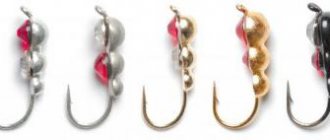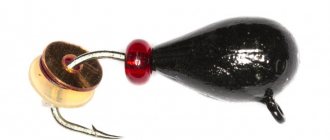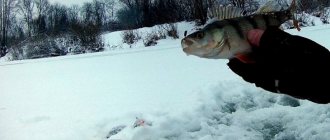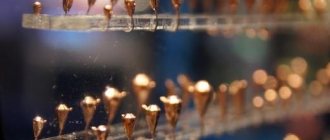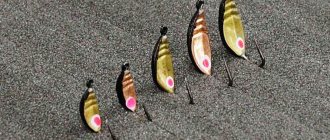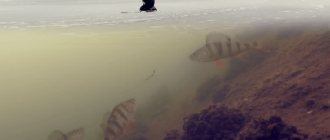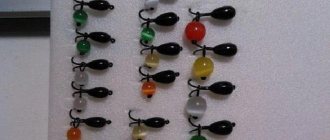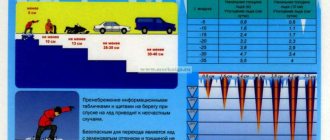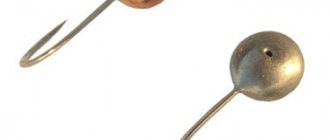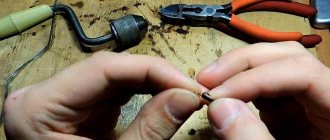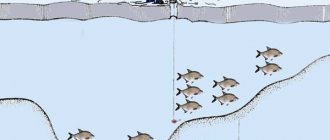Catching perch with a reelless reel in winter
During the period of first ice, perch becomes active and constantly moves around the reservoir, so you should always look for it. It will be good if you can find a place with a pitty-lumpy bottom. Moreover, it may be very far from the shore, but these are the places that large individuals prefer.
Detection of perch in a particular place depends on:
- water temperature in a given water area,
- availability of food,
- atmospheric pressure,
- degree of illumination,
- amount of oxygen in water.
In many ways, the behavior, and therefore the “walks” of the perch, depend on the water level and the presence of hydraulic structures, which dramatically affect many indicators of fish activity. Read also: The best balancers for perch
Perch is considered a light-loving fish, so it is reasonable to assume that it prefers areas with good lighting. If the perch is full, its activity decreases and no amount of bait can force it to take the bait, although in the hole you can observe the movement of the school. The most active perch bite is observed in the first way. And also the last ice, since before spawning the fish need to feed heavily. This is interesting: For perch on the first ice
Choosing a bait for perch: reelless or jig with a nozzle?
It is fishing for perch on the first ice that best helps to hone your fishing technique, check the suitability of gear, select the optimal jig in shape, size and color, and find catchable jigs that are most suitable for a given reservoir.
In principle, if we consider a jig as a means of delivering bait to the fishing point, its shape does not matter much; the classic drop and ball are quite sufficient. You just need to remember that the “drop”, like the “ovinka”, adds additional attractiveness to the bait complete with a nozzle, but the “ball” is the only one of all forms that has an undeniable advantage in hookiness due to the maximum reach of the hook, all other things being equal. If at some period of fishing the bite becomes so intense that the fish instantly grabs the jig that has just been delivered to the fishing zone (and this often happens when fishing when going out on the first ice, hence the expression “Bite on every retrieve”), then the use of a “ball” “In this situation, I consider it the most effective: the number of escapes and empty bites will be reduced to a minimum. Also, the use of a small, 1.5-2.5 mm in diameter, “ball” paired with a minimum-sized attachment, for example, a food bloodworm, can be very useful in case of a sudden complete cessation of biting and in the dead of winter.
The use of a ball-shaped jig is especially effective during a “mad” perch bite: the number of trips is minimal
Tackle for catching perch in winter
When we go fishing for perch with a reelless reel, we sometimes hesitate: which tackle will be the most effective? On the last ice, most anglers catch perch using small spoons and a jig with a nozzle. We give preference to small baitless baits such as front sights and jigs and their combinations.
The best reelless reels for perch fishing
Traditionally good nozzle jigs are:
- "Uralka". The most universal of all jigs is the “Uralka”, with a yellow, white, orange or red bead on the hook. To achieve success in deep and shallow water fishing, you need to use a thin fishing line with a diameter of no more than 0.12 mm, or better yet, a diameter of 0.06-0.08, have a properly made nod and a fishing rod that is convenient for active play.
- “pellet” A tungsten “pellet” with a white or black bead is considered an all-season bait. In some cases, a lead “pellet” with a black or brown bead on the line and a piece of red or orange sponge on the hook works well. Other times, a combination of white and red or red and black beads provides a stable bite. Free play of the beads is required - it creates an additional noise-attracting effect.
- "ant". When catching perch with an ant, first of all use a bronze color with bright colored eyes on the sides, as well as jigs with brass or copper soldering on the sides. As for the size of the “ant”, in most cases I prefer to use baits of the minimum size for the given conditions. That is, for fishing at a depth of up to 1.5 m I always use the smallest available size; at greater depths I also try to use “ants” of the same size. And only when fishing in the current at a depth of more than 4 m, sometimes I use medium-sized “ants”.
- “ovinka”, Much more important when choosing a jig is its weight, diameter, and also the hook. It is the latter, in case of poor compatibility with fishing conditions and, especially, poor quality, that can cancel out many efforts. A hook usually has two problems - it is dull and small. Fortunately, this is somewhat easier in modern jigs, but many old lead jigs have simply terrible hooks. One piece of advice might be to avoid buying the cheapest lead jigs, or to keep an eye out when purchasing them.
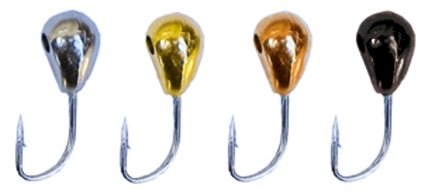
- "droplet" They sway better when the winter fishing rod moves. Jigs - droplets are used for reelless fishing of perch with an inclined suspension. They also attract fish when they move on the bottom.
As for color, preference should be given to:
- black,
- purple,
- brown,
- green,
- reddish baits.
On the shank of the hook you can plant a grain from:
- white,
- yellow,
- red
- black rubber.
In more turbid water, it is advisable to change the rubber to white dense foam rubber or yellow beads.
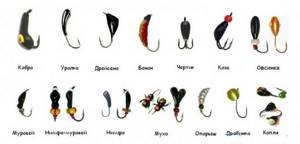
Tungsten jigs are good because they are heavier, which means they are easier to get to the bottom. A tungsten jig has a good effect on the nod game, and it is more often used when fishing at great depths, since it is quite small with a large weight. On the last ice, perch most often prefers a tungsten “drop” of black or red color with a diameter of 2.5–3.5 mm. Perch is well attracted to jigs with a red and black pattern in the shape of a fish eye.
Very often, anglers catch perch using a baitless “devil,” but not everyone knows that sometimes you can increase the catchability of the gear by adding a tiny jig or fly to the line above the main bait.
The fly can be made by wrapping a size 18-22 hook with a long shank with red silk thread. Sometimes black and white threads are attractive to perch. A nymph can also be used as a second bait.
One of its variants is made like this. A gray bead is put on hook No. 18 - it will imitate the head of an insect; then a piece of polyethylene is placed on the fore-end and a thin copper wire is wound around it - this will be the body. The polyethylene should be straightened and a forked tail should be cut out of it (picture on the left). Such a nymph has gliding movements, which perch really like. “Devil” and “nymph” complement each other, and two perches can bite on them at the same time. The beads placed on the shank of the hook themselves create characteristic vibrations that attract the attention of the fish.
Another category of baitless baits that attract perch are flat jigs. The best performance is achieved by a flat, elongated jig in the form of a slightly bent oval. The weight of the jig can be increased or decreased by changing the thickness of the plate from which it is made. The materials used are brass, bronze, silver, and tungsten.
DIY reelless jigs
You can learn the intricacies of making windless jigs with your own hands by filling the crowns with solder or lead by clicking on the link at the bottom of the article.
True, there are tips on how to make ordinary jigs with your own hands, intended for catching fish with baits of natural origin, which, given the specifics of this topic, need minor additions.
When making jigs designed for reelless fishing with your own hands, it is advisable to solder hooks with a long shank into the bait in order to place various oscillatory elements on them.
Reelless jigs with a significant inclination of the longitudinal axes are considered more attractive to fish. Such a structure can be achieved by shifting the opening of the hole for passing the fishing line closer to its rear part during the process of making the bait yourself. Using the same principle, you can convert an ordinary bait into a reelless jig with your own hands.
You can make the basics of homemade reelless jigs of different constructions using the tips in the article Do-it-yourself jigs.
Bait when catching perch in winter using a reelless bait
Despite the fact that fishing is carried out without bait, bait is another success factor. However, it is necessary to feed the place when the bite is weak or completely absent. It happens that with the addition of bloodworms to the hole, the perch’s bite on the bloodless one stops completely. In this case, you need to change the place. But sometimes adding bloodworms to the hole, thrown in pinches from above, provokes the perch to grab a baitless jig.
In winter, bloodworms, maggots, and chopped dung worms harvested in the fall are used as bait.
Video: Homemade reelless jigs
Continuing the topic, watch a short video showing the vibrations of homemade reelless lead jigs of different classes under the control of a side nod. And first, pay attention to how the shock absorber spring swings from right to left when the shock absorbers themselves oscillate in the vertical plane. That is, from top to bottom.
In addition, watch the same video again and pay attention to the frequency and amplitude of vibration of the nod spring, which is at least 100 mm. At the same time, reelless homemade jigs with artificial baits on the hooks are practically in a state of vibration near the resting point.
If you appreciate what is shown in the video and you are satisfied with the frequency and amplitude of vibrations of reelless jigs of different classes under the control of the nod of the spring system, then I suggest making similar shock absorbers with your own hands.
Catching perch in winter with a reelless video
An underwater camera records how a perch reacts to a mothless ant with a yellow bead. Filmed in the middle of nowhere. depth 1.20 cm.
Catching perch with a reelless video . The fishing technique that day was slightly changed to a more delicate one. Having drawn conclusions from my previous fishing, I decided to catch perch using a reelless reel, but the search is still carried out using a balancer. A few words about the tackle, an ordinary balalaika with 30 m of Sunline Siglon fishing line with a diameter of 0.1 and 1 kg for breaking. Tungsten jig Shark Ant. I decided to add bright beads to the main line above the jig; this, in my opinion, certainly played a role in fishing. The fact is that when playing with a jig, the beads hit each other freely along the fishing line, but to achieve the best effect, you need to shorten the length of the nod to a minimum, that is, make it as rigid as possible. A dozen holes are cut, the search for perch begins with a balance beam, the first poke in the hand, hook and the first one goes... I immediately lower the balancer to concentrate the flock under the hole and make sure that this is not the only specimen, tossing, hooking... Jig, your time has come
